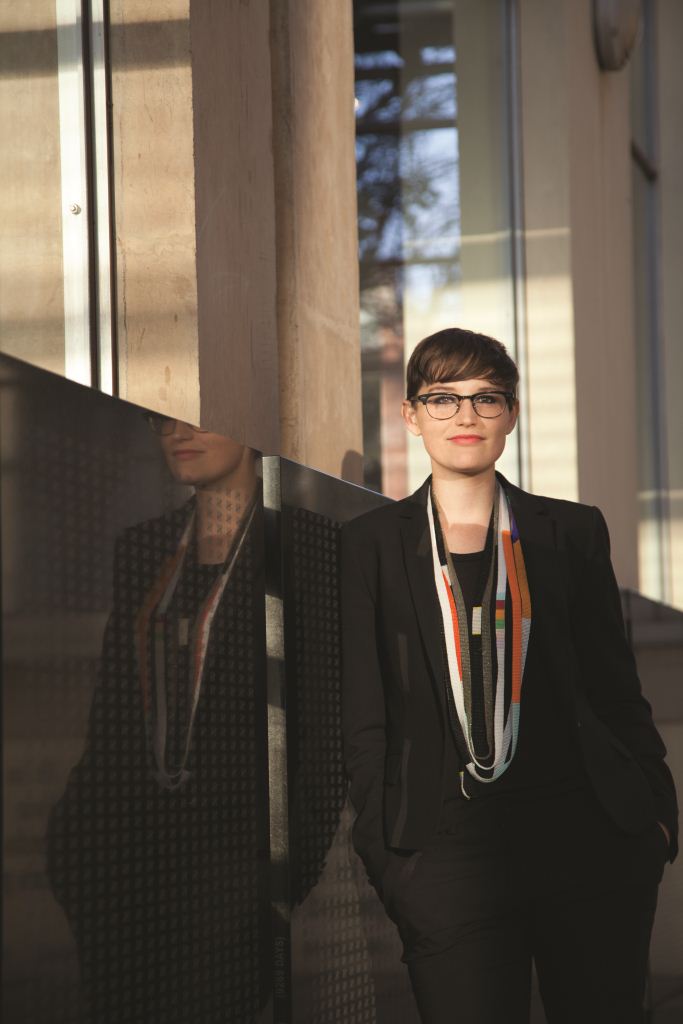It’s a simple sculpture of a woman and a blue dress. Phila Ndwandwe was a general in Umkhonto we Sizwe (MK) – South Africa’s African National Congress’ armed wing – who was held captive during the height of apartheid. She was tortured for ten days and left naked in her own blood. But one day, in captivity, she comes across a blue plastic packet. By the time her torturers returned, the general donned the packet as a pair of panties to reclaim her dignity. Ndwandwe’s body was found naked in a shallow grave, with the thin piece of plastic still covering her private parts.
The artwork by artist Judith Mason, hangs from the rafters of the Constitutional Court gallery.
“The powerful thing was that the men remembered it, among the many people they may have put to death on behalf of the apartheid government… I think many women can relate to Ndwandwe’s plight,” says Stacey Vorster, curator of South Africa’s Constitutional Court Art Collection.
Telling the stories behind art is all in a day’s work for Vorster. It’s not all glamor and gala events. In between working for the court, Vorster is also a full-time associate lecturer in history of art at the University of the Witwatersrand. On any day she can be giving tours to princes (Prince Edward visited last year), to climbing a ladder and patching walls. She keeps two pairs of shoes handy, one flat, the other heeled, for such emergencies. She also carries tissues.

Loading...
“As I was telling the [blue dress] story to some visiting judges from Germany, one man started crying, and I burst out crying in response. I am an emotional person, and I sometimes get tripped up by these moments. Most women don’t want to seem emotional, especially in the workplace. I often get overwhelmed by this collection, I can’t help but cry.”
It’s not easy to preserve and maintain the 404 pieces in the collection worth over R50 million (almost $5 million), but Vorster does what she can on a tight budget. One of her big headaches is money. She has to fundraise internationally, as no local donations can be accepted. The rule of the Constitutional Court is that South Africans can’t sponsor the art collection for fear that it will be seen as a potential conflict of interest. Apart from its first artwork which was bought for R10,000 ($1,000) by Justices Albie Sachs and Yvonne Mokgoro, every other artwork has been donated. Vorster hopes to preserve and let it interact more with the public, if new funders can be found.
It hasn’t stopped Vorster from trying to shake things up.
“I am the only curator on the project. Most collections this size, in terms of international standards, would have at least two full time people looking after them… One of my concerns about the collection is that we don’t have enough artworks made by women. We also don’t have enough artworks that speak of women’s issues. As a collection that speaks to the identity of a nation and its journey to a nascent democracy, it’s important to me that it is representative of a variety of views… Little did everyone know that I am here to cause trouble; a curator as a trouble-maker is an idea that interests me. It’s not a job of simply putting objects into a room. We are here to ask questions and stimulate dialogue. Art is a powerful tool for change,” she says.
By the time we leave the gallery, it’s dark outside. Vorster prepares to meet a group of American tourists, here to see the collection, after hours.
“I see the collection through other people’s eyes and I feed off of it.”
Loading...
